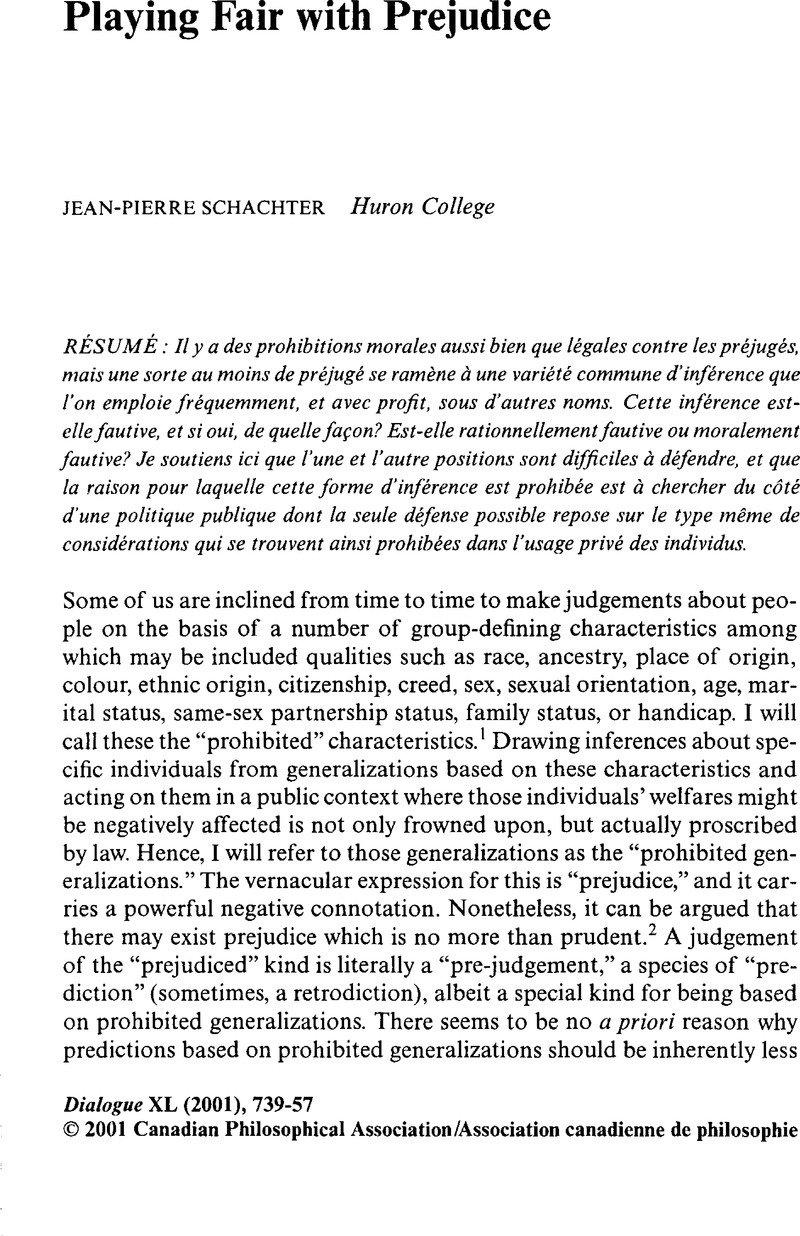No CrossRef data available.
Article contents
Playing Fair with Prejudice
Published online by Cambridge University Press: 13 April 2010
Abstract

- Type
- Articles
- Information
- Dialogue: Canadian Philosophical Review / Revue canadienne de philosophie , Volume 40 , Issue 4 , Fall 2001 , pp. 739 - 758
- Copyright
- Copyright © Canadian Philosophical Association 2001
References
Notes
1 The list comes from the Ontario Human Rights Code which designates them as “prohibited grounds”: See Revised Statutes of Ontario (R.S.O), 1990, c. H. 19, s. 1; 1999, c. 6, s. 28(1).
2 There are cases in which a judgement or act might be considered prudent even if unsupported by any grounds or even where there exist grounds to the contrary. John Pollock, for example, distinguishes between prudential and epistemic rationality, where the first may well not involve good grounds. Others have distinguished between pragmatic and epistemic justification. There are also cases in which the holding of one unsupported belief has historically led to more desirable results within the agent's framework than holding any other. I would call this last both “prudent” and “rational,” and will argue that “prejudice” may at times be rational in this sense.
3 William K. Clifford asked whether we had a moral obligation to moderate our beliefs to our evidence; the question in this paper extends the ethics of belief in asking whether there can be rationally justified beliefs we have an obligation not to believe. See his “The Ethics of Belief,” reissued in The Ethics of Belief and Other Essays, introduced by Madigan, Timothy J. (New York: Prometheus Books, 1999).Google Scholar
4 John Pollock offers a way of deriving definite probabilities from indefinite. For a summary, see his Contemporary Theories of Knowledge (Lanham, MD: Rowman & Littlefield, 1986), pp. 103–105Google Scholar. He cites his own “Foundations for Direct Inference” (Theory and Decision, 17 [1978]: 221–56) for a detailed account of the relation.Google Scholar
5 For each characteristic added, the size of the relevant population shrinks, and as we approach the actual individual, that population approaches 1. This means that the generalizations for the more abstracted individual are better supported than for the more concrete individual.
6 A recent news television item on Extra (January 23, 1999) concerns new home owners' insurance regulations which do not extend coverage to families owning pit bulls or other aggressive dogs. This is not discrimination against the animals, nor would it count as discrimination against the families since the operative factor is not on the prohibited list. Notwithstanding, it does show that we are content to apply group information analogous to that of race in humans in a predictive way with a high level of confidence to mammals other than the human without being charged with unfairness.
7 There has been considerable public attention given recently to a police practice called “racial profiling,” in which crime statistics for specific racial subgroups are used to determine police reaction with respect to, for example, traffic violation stops and personal searches (cf. Barovick's, Harriet “DWB: Driving while Black—Incidents in New Jersey and Maryland Heat Up the Issue of Racial Profiling by State Highway Patrols,” Time Magazine, June 15, 1998, 151, no. 23.Google Scholar
8 After a recent jailbreak in Jamaica during which twenty-one extremely dangerous offenders escaped, Canadian immigration officials indicated that they intended to increase border vigilance with respect to Jamaican males. Canadian Jamaican spokespeople objected on the grounds that this was discriminatory behaviour in which Jamaican males were to be unfairly singled out for unpleasant scrutiny. The odd implication of this is that presumably these spokespeople would have been content with increasing border vigilance for all incoming persons, including Jamaican males, even though it was known that an increased risk existed only respecting Jamaican males.
9 “Better that ten guilty persons escape than that one innocent suffer,” says English jurist William Blackstone. The ratio 10:1 has become known as the “Blackstone ratio.” See Blackstone, William, Commentaries on the Laws of England (London: A. Strahan, 1809), Bk. 4 (“Public Wrongs”), chap. 27, p. 358.Google Scholar
10 Kant, Immanuel, The Critique of Practical Reason, translated by Abbott, Thomas Kingsmill (New York: Prometheus Books, 1996 [1788]), p. 109.Google Scholar
11 The term “prejudicial” in this usage implies inappropriate doxastic potential. “Prejudicial” information has the potential for inappropriately persuading, that is, it is persuasive information that falls outside of legally allowable evidence. Prohibited group information is thus paradigmatic of “prejudicial” information.
12 Some might argue that we have been unfair even if the person does turn out to be bad, that the question of the fairness of the judgement or the act is independent of the consequences of the judgement or the act.




